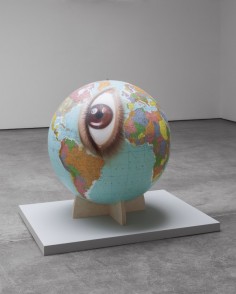Sam Durant
Invisible Surrealists
source: samdurant
Sam Durant is a multimedia artist whose works engage a variety of social, political, and cultural issues. Often referencing American history, his work explores the varying relationships between culture and politics, engaging subjects as diverse as the civil rights movement, southern rock music, and modernism. His work has been widely exhibited internationally and in the United States. He has had solo museum exhibitions at the Museum of Contemporary Art, Los Angeles, Kunstverein für die Rheinlande und Westfalen, Dusseldorf, S.M.A.K., Ghent, Belgium and the Govett-Brewster Art Gallery in New Zealand. His work has been included in the Panamá, Sydney, Venice and Whitney Biennales. Durant shows with several galleries including Blum and Poe in Los Angeles, Paula Cooper Gallery in New York, Praz-Delavallade in Paris and Sadie Coles Gallery in London. His work has been extensively written about including seven monographic catalogs and books. In 2006 he compiled and edited a comprehensive monograph of Black Panther artist Emory Douglas’ work. His recent curatorial credits include Eat the Market at the Los Angeles County Museum of Art and Black Panther: the Revolutionary Art of Emory Douglas at The Museum of Contemporary Art in Los Angeles and the New Museum in New York. He has co-organized numerous group shows and artists benefits and is a co-founder of Transforma, a cultural rebuilding collective project that began in New Orleans. He was a finalist for the 2008 Hugo Boss Prize and has received a United States Artists Broad Fellowship and a City of Los Angeles Individual Artist Grant. His work can be found in many public collections including The Art Gallery of Western Australia in Perth, Tate Modern in London, Project Row Houses in Houston and the Museum of Modern Art in New York. Durant teaches art at the California Institute of the Arts in Valencia, California.
.
.
.
.
.
.
.
.
.
source: byamoret
Cartographer engaged in current day charting of the overwhelming rise of imperialism, capitalism, and corporate domination, Sam Durant proves that the maps we once relied on as evidence of progress are now visual representations of thwarted corruption. The title of the show “laissez faire et laissez passer, le mode va de lui même” is borrowed from Jean Claude Marie Vincent de Gournay, a French Commerce Secretary during the 18th century who popularized the “laissez faire” mentality of the free market. A series of six large scale globes, supported by cables extending from the ceiling and the floor, create the illusion that the fabricated globes are levitating and thus enacting the title of the show, “Let do and let pass, the world goes on by itself.” From a distance the globes seem a common artifact found in classrooms and libraries, but upon closer inspection the viewer stumbles upon statistics that Durant has infused across the representations of various nations. “Fortune 500” reflects the world as home to giant corporations, which transforms countries into ephemeral commodities. Overwhelmed by Pepsi Co., Pfizer Inc., Bank of America, Goldman Sachs, Exxon Mobile Corporation, Lockheed Martin and a slew of others, Durant seems to suggest that as the world “has gone on by itself” it has become overwhelmed by grandiose imperialist prospects infused by the profit motive. One globe charts the “top ten places for tax evasion and money laundering,” while another compares the top ten countries famous for their prisons and art auction houses. The juxtaposition of art and crime runs though the entire exhibition, as the artist’s medium is the hand the renders humanity into a state of affairs marked by corruption. The “Mirrorplanisphere” is a twenty-four foot long metal floor map cut to the shape of an orange peel, the blotches of shifting color representing nations. While Durant invites the viewer to stand on top of the sheet, which literally reflects their position on the map and thus their place in the world, the piece feels foreboding. The forms collide together and appear like PANGEA, the world’s enormous single land mass dating to the Paleozois and Mesozoic era around 250 million years ago before continental drift began. “Mirrorplanisphere” envisions that the expansion of the universe is coming to an end; now it must contract in order to start anew.
.
.
.
.
.
.
.
source: artspycn
在此次展览上,杜兰特为观众们提供了一个仔细思考“地图制作”更广泛的意义与暗示的机会。艺术家通过绘制地图来表现信息,从各个不同的角度为我们呈现出与美国新自由主义运动相关的信息。
此次展览被分为三个版块:分别展出了一系列地球仪、一系列经修改过的地图以及一大张铺在地板上的铝制地图——观众可以在这张铝制地图上随意行走。杜兰特与一家以伊利斯诺州为基地的地球仪制作公司Replogle合作,一起制造了6个独特的大型地球仪。这些地球仪从天花板上悬吊下来,因而它们可以自由地在整个展览空间中移动。地球仪上描绘了一系列不寻常的资料,直接或是间接地涉及到一些经济问题。此外,杜兰特还改变了商业制作墙挂式地图和旅游地图的目的,创作了一系列经过修改和拼贴的地图,并且用一些政治性的文字和引语做了分层处理。这些作品探索了帝国主义存在的一些历史问题,以及它们与当前地缘政治环境的关系。
在画廊某一间展厅的地板上,铺着一张足有24英尺长的铝制地图。这张地图被裁剪成地球表面等面积投影的形状,各大洲以及各个国家都用彩色的蜡纸加以了区分。这张地图是整个地球表面的真实写照,能够产生一种站在世界内部、向外观看整个地球表面的效果。


